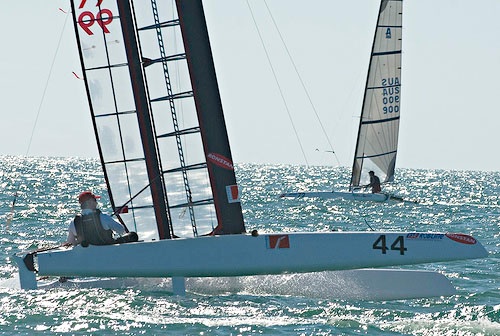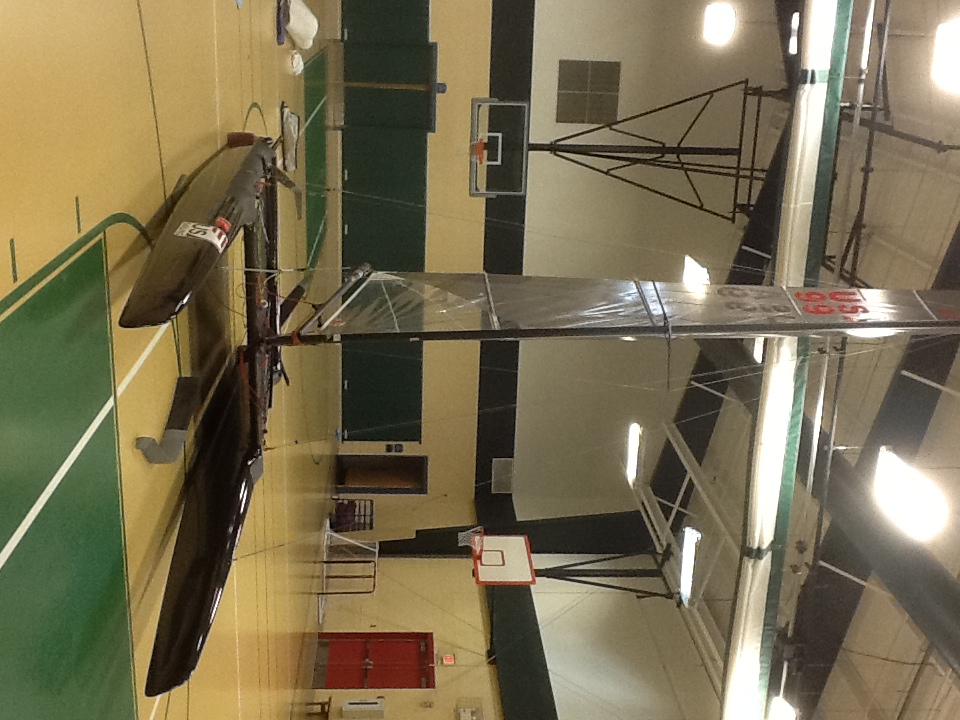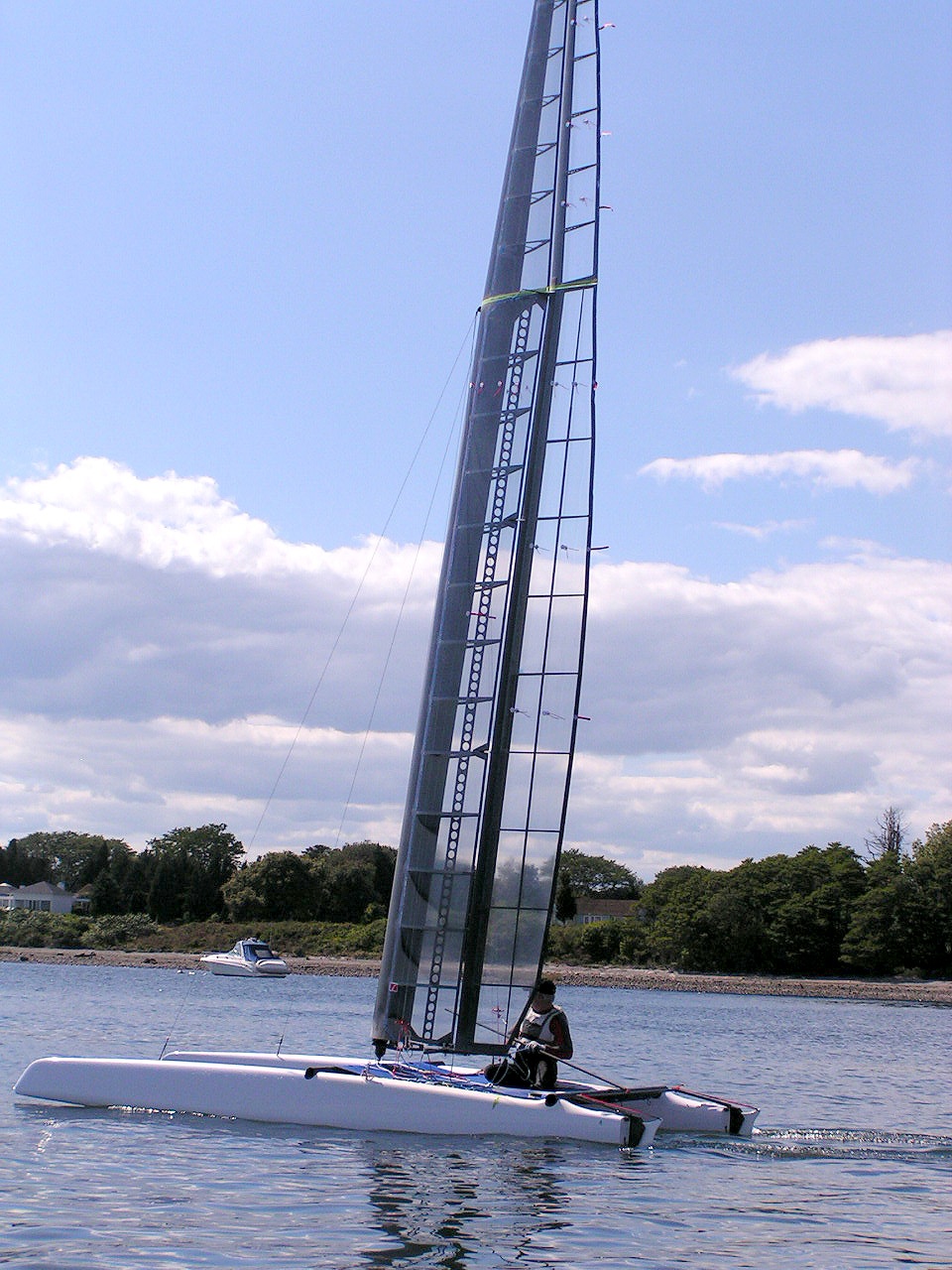Ben Hall's 'A' Cat thoughts.
As a result of his Lockdown Interview, it inspired Ben Hall into thinking further on his 'A' Cat life. He shares those interesting thoughts and memories with us.
WHAT IS YOUR FAVORITE A CAT?
Of the 34 A Cats I have owned my favorite is my Barracuda 2 aka Black Beauty. This boat was designed by Peter Cogan as a result of continued design improvement from his EVO, EVO 2 and the original Barracuda. This design has low freeboard reducing windage drag significantly. The original carbon molds for the Barracuda were modified to incorporate flatter bottoms similar to the DNA.
The hulls were cured in one piece in the Hall Spars autoclave. Hull laminate was high modulus prepreg carbon with 6mm honeycomb core. The hulls were cured at 250F and 35 psi (3 times vacuum pressure) Both front and rear beams were mandrel tooled high modulus prepreg carbon autoclave cured.
Ken Madeiro was the mastermind behind the lamination and structural assembly of the platform. Of all the boats we built, this was also Kenny’s favorite. The lamination was so good that we decided to clear coat the hulls to show off the carbon look.
I ended up selling the boat over protestations from both Kenny and my wife, Nan (it is also her favorite A Cat). When the boat came back on the market two years ago I asked Nan if I should buy it back...without a moments hesitation she said “ Get it!” So Black Beauty is back “home” and will not have a for sale sign on it ever again.
She has recently been upgraded with a solid tramp, actively adjustable boards, and deck sweeper.
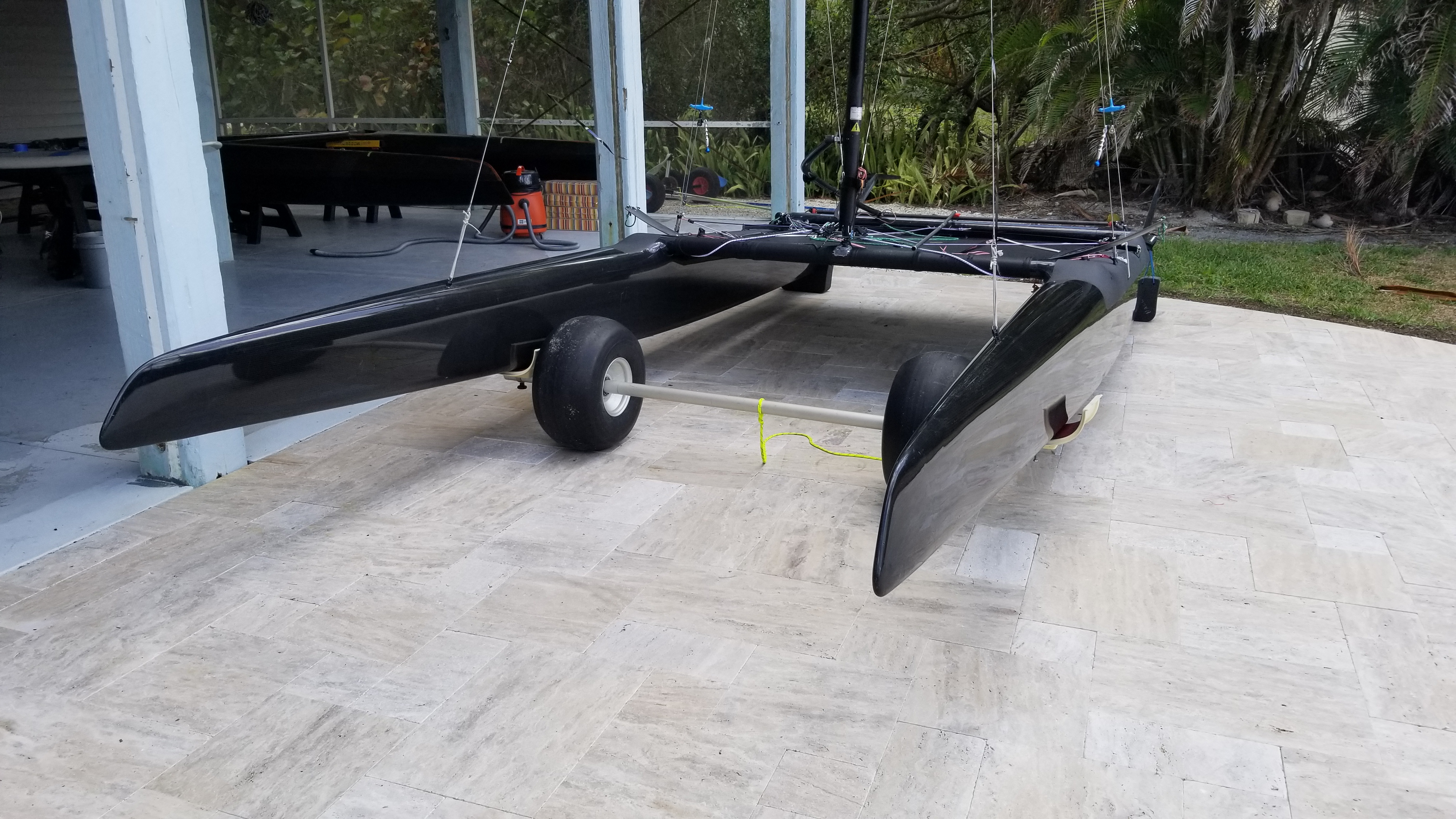
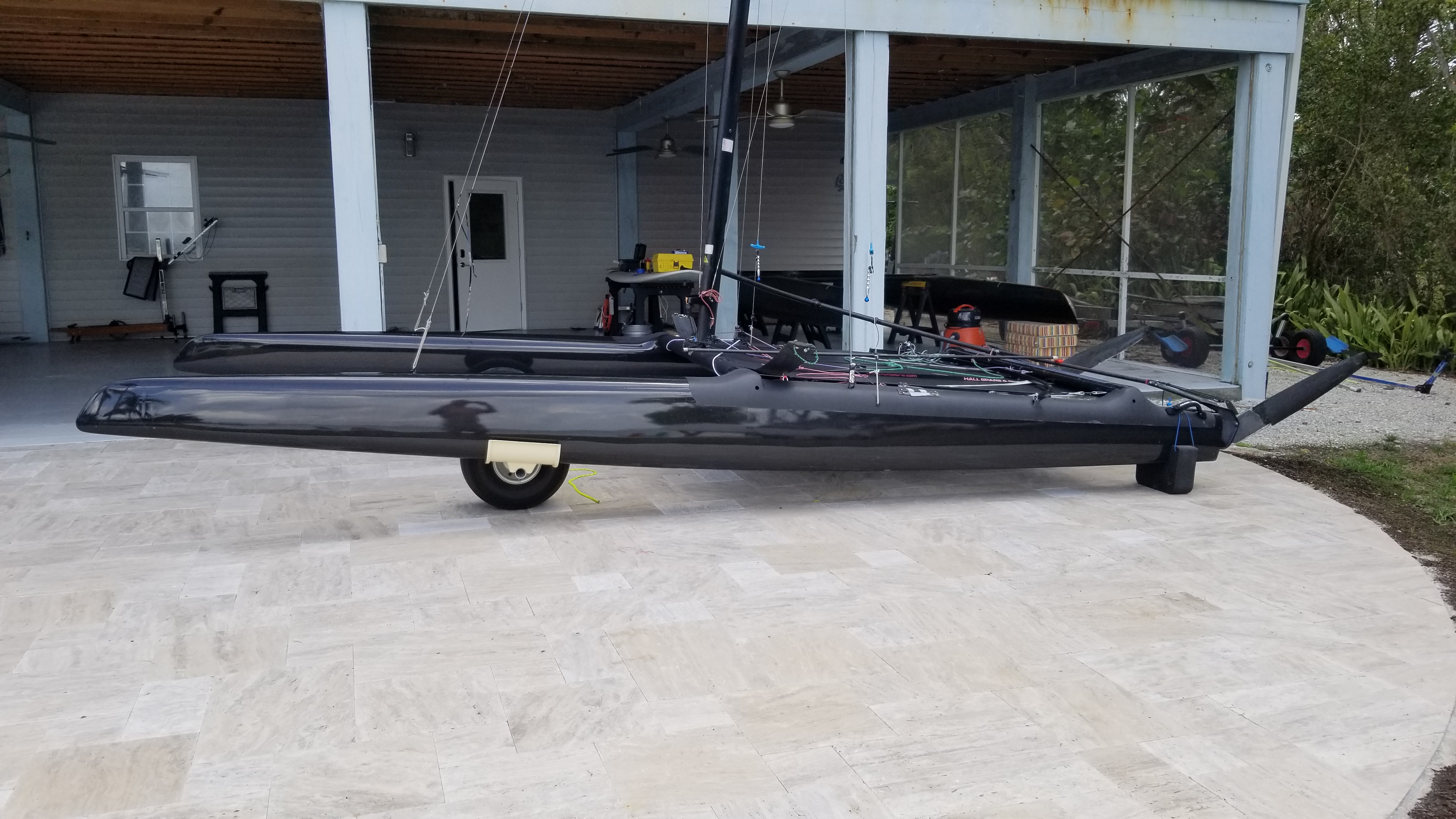
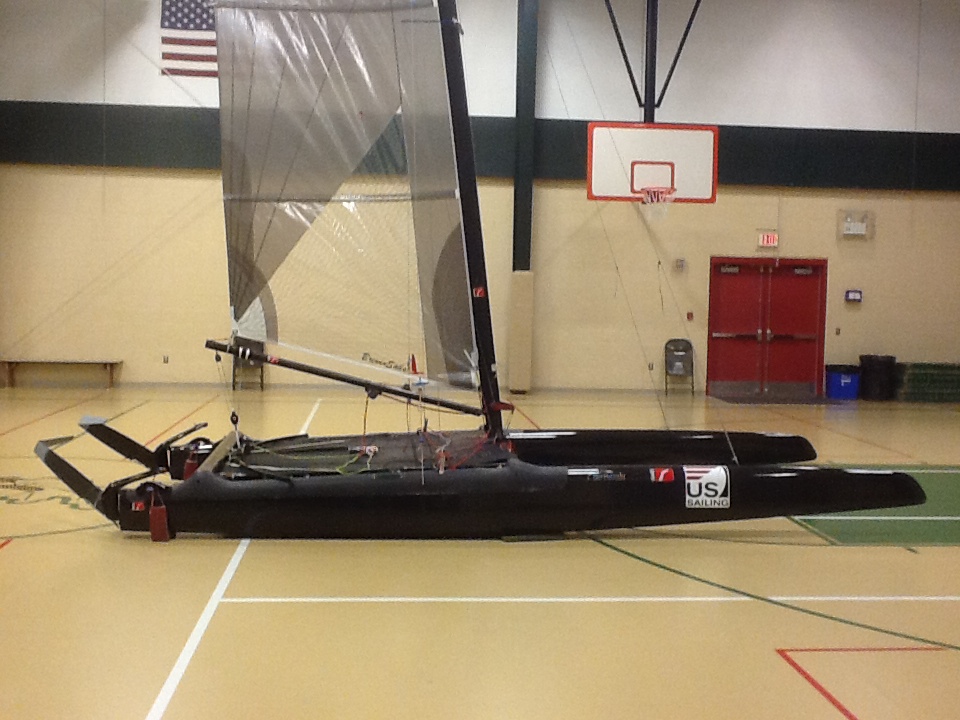
- TELL US ABOUT THE SOLID WING YOU DID IN 2007
The solid wings on the C Class Cats always intrigued me. Why not try one on an A Cat?
They looked really complicated to build and looked so fragile. So I asked Steve Clark (Cogito brainchild) what he thought and he said no problem and lent me the plans to the Cogito wing...yup it was quite complicated and difficult to imagine how I would build it. After a a quick review with Steve he suggested I contact Dave Hubbard who was the wing designer guru of Patient Lady and Cogito. Dave was great...he helped me understand how to simplify the design and construction. We decided to go to a two element wing instead of a three element like was on Cogito. He fed me designs for shapes, laminates and construction techniques. Since I wanted to keep the project under wraps I decided to build the elements in my basement workshop at home. It was like building a big model airplane wing... lots of small, light parts with tons of glue joints. To keep the cost down I tried to use our stock carbon materials at Hall Spars. The wing was designed with a top section and bottom section to facilitate transport and storage. I started with the top section (this section was from the hound up) making the two elements. I learned how to apply and shrink the Clysar. The hinge sections were critical to get the correct geometry.
When I got half way through the two bottom elements I realized that the build was getting too big for my shop. So I moved the whole project to our “America’s Cup “ shop separate from our main building. Kenny Madeiro then jumped in to help and was the force in finishing the project at the highest level. We bench tested all the wing systems including the twist controls. When we finally put the wing up in the parking lot many pictures showed the cat was out of the bag.
When I rigged the boat at Bristol YC, Steve Clark was right there with encouragement. Just as I was pushing off the ramp I asked him if I would have to learn to sail all over again... he said 'Hell no...just trim the wing and go sailin!'. It was actually a lot easier than I thought. I trained for about a month leading up to the 2007 Worlds in Islamorada. We made several small mods to the wing to strengthen and stiffen the #2 element of the bottom section as well as mods to the EVO platform (Peter Cogan design). The challenge in the whole project was to make the lightest wing we could and try to keep the all up weight of the boat at 75kg. The wing complete with rigging was only a few kilos heavier than the standard mast, sail, boom and traveler. The kicker was that the CG of the wing was about a meter higher than standard. At the Worlds the boat weighed right on minimum.
One of the concerns with the wing was its ability to survive a capsize. We all thought it would be game over for the wing in a capsize, so I did not even rig a righting line on the boat. While out for a practice a few days before the Worlds I did capsize. I looked and everything looked in one piece....hmm...no righting line.... OK, so I dismantled one of the control lines to fashion a makeshift righting line and got the boat back upright. There was virtually no damage to the wing, so it did survive...phew. A day later while tuning against the top group I switched boats with Glenn Ashby to let him try out the wing. We went off downwind and I sailed from behind him and went lower and soon through his lee...ouch...this did not bode well for my project. Then he stopped, fiddled with a few adjustments and then proceeded to put over 100 meters on a group of the top A Cat sailors. Wow...maybe I do have something here!
I went on to placing where I normally did on a world level...top third of a 90 boat fleet. Not bad but not my goal...The wing was the center of a lot attention ashore....especially when my wife Nan ( the wing Sherpa) and I would calmly take the wing sections out of the trailer box, assemble the top and bottom sections, attach the rigging and get the boat ready to sail in under 30 minutes.
In 2009 the Oracle team, headed by Mike Drummond, bought the wing and had it shipped to San Diego. I flew out in February to do a show and tell for the design and sailing team. That day we launched Mike’s A Cat with the wing and went out for a test sail. Mike, Jimmy Spithill and Glenn Ashby took turns sailing it. They used the wing for many tests including stepping and lowering the wing. A few days after that they had a team meeting and made the decision to put a giant wing on the 90 ft Tri they built to challenge Alinghi for the America’s Cup and the rest is history.
- 'A' CATS AND THE AMERICA'S CUP
Just about every team in the Americas Cup after the year 2000 had designers and sailors who actively raced A Cats. We made masts for Alinghi, Luna Rossi, Mazcalzone Latino, Sweden and Oracle. It was always fun to attend design meetings at the various compounds...we would discuss build schedules, secrecy, laminates, design and build tools for about 30 minutes and then talk about A Cat design ideas for two hours.
Mike Drummond, Glenn Ashby, Jimmy Spithill, Luc DuBois, Pete Melvin, Scott Ferguson, Dirk Kramers, Andrew Gaynor, Peter Burling, Blair Tuke, Dean Barker and Ray Davies all had input on design and how to improve the sailing of the innovative designs their teams had created...and the foundation of many ideas came from experience in the A Cat. Probably the biggest game changer was when Glenn Ashby coached his Team New Zealand squad (Burling, Tuke and Davies) to get the foils and sailing techniques advanced so that the boats could foil downwind. Using the newly created J boards made by DNA, Glenn and his boys finished 1,2,3,5 in the Takapuna Worlds. This was the real start of the foiling revolution. And at the same regatta, Pete Melvin introduced the first modern decksweeper main, curved boom and sealed tramp...all derivatives of his AC design experience.
- WHAT 'A' CAT INNOVATIONS WERE GAME CHANGERS?
It was before my time on 'A' Cats, but one of the first a-ha moments was when Lake Hopatcong sailor, John Koeck, started using a trapeze. Then a little later the Aussies and Italians started making fiberglass(and soon after carbon fiber) hulls which made production boatbuilding a reality. In 1996 the first carbon masts came on the scene. Many said too expensive, too fragile...it will ruin the class. Nope... within one year all the masts at the Worlds went from aluminum to carbon. The boats became much easy to right after a capsize (safer) and gave several companies the opportunities to tool up and provide the class with options for their rigs. Then rudder winglets...the first to use them was Steve Clark at the 2002 Worlds in Marthas Vineyard. At the North Americans prior to the Worlds, a 40 knot squall ripped through and decimated the fleet...many broken masts and most of the fleet capsized. Steve was the only one who could keep his bows up and not pitch pole. Glenn Ashby as well as a few others got separated from their boats and Steve sailed around and picked each one up and returned them to their capsized boat!
After that it took many years to realize the real value of rudder winglets. Next were angled boards and then curved boards starting in 2006. There was big discussions at the Alinghi camp which were better. Unfortunately I did not incorporate either winglets or lifting boards to my wing platform. That would have made a big step in reducing the pitching the higher CG wing produced. Next were the continuous development of foiling boards and rudders. DNA led the way with their early J Boards which morphed into Z boards. Exploder took up the challenge with many iterations of boards and rudders...the result has been A Cats that foil really well both up and down wind.
Oh and I have not mentioned that solid wing...still legal...the only one built that went to sail in major regattas. Most likely would have had a much better result with a top sailor (like Glenn) sailing it...but with the modern foiling boat, it could be a new weapon. With its extra power a sailor could be up on the foils quicker and be since the pitching problem is all but solved why don’t we see someone trying this again. Cost and ease of going sailing is still a negative factor, but who knows, maybe one will surface for the 2021 Worlds in St Petes.....

